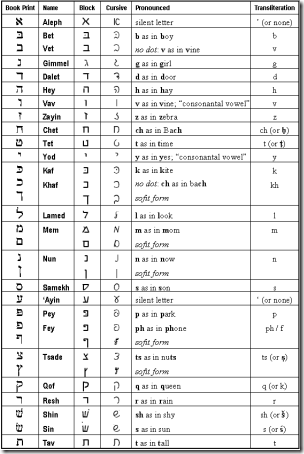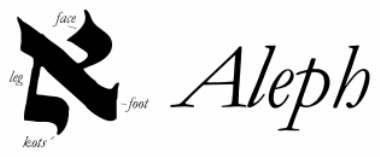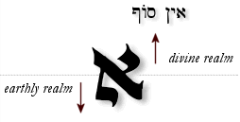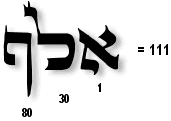 I have recently found a Hebrew for Christians website that will be found to be very useful in studying and learning to read, write and speak the Hebrew tongue and to also study the etymology, pictographs and history of the language. From a Biblical perspective, from what I have gleaned in a very short period of time whilst studying, you will see how the Hebrew Aleph-Bet (pronounced “ah-lef”-“bate”) has YHVH (GOD) in the very letters and words of His divinely inspired Aleph-Bet. When Yeshua HaMashiach (Jesus Christ) said that He is the “Aleph and Tav” (Alpha and Omega in Revelation 1:8,11; 21:6; 22:13) He was saying the whole of YHVH’s Word from the first letter to the last letter speaks of Him! This is why no-one, especially modern-day bible translators and publishers, are NOT to add to or diminish from the Word of God! Our Lord Yeshua said,
I have recently found a Hebrew for Christians website that will be found to be very useful in studying and learning to read, write and speak the Hebrew tongue and to also study the etymology, pictographs and history of the language. From a Biblical perspective, from what I have gleaned in a very short period of time whilst studying, you will see how the Hebrew Aleph-Bet (pronounced “ah-lef”-“bate”) has YHVH (GOD) in the very letters and words of His divinely inspired Aleph-Bet. When Yeshua HaMashiach (Jesus Christ) said that He is the “Aleph and Tav” (Alpha and Omega in Revelation 1:8,11; 21:6; 22:13) He was saying the whole of YHVH’s Word from the first letter to the last letter speaks of Him! This is why no-one, especially modern-day bible translators and publishers, are NOT to add to or diminish from the Word of God! Our Lord Yeshua said,18 For verily I say unto you, Till heaven and earth pass, one jot or one tittle shall in no wise pass from the law, till all be fulfilled. ~ Matthew 5:1817 And it is easier for heaven and earth to pass, than one tittle of the law to fail. ~ Luke 16:17
A “jot” is the Strong’s Greek word #2503 iota “. . . of Hebrew origin (the tenth letter of the Hebrew alphabet) . . .” which is the Yod (pronounced “Yode” and is an ’ ) and a “tittle” is the Strong’s Greek word #2762 keraia which refers to “. . . something horn-like, i.e. (special) the apex of a Hebrew letter (figurative the least particle).”
What is very helpful is if you have a Hebrew and English Tanakh (Old Testament) and also a Brit Chadashah (New Testament) which you can compare as you study. I have both and the English Scripture portion that runs side-by-side with the Hebrew is the Authorised King James Holy Bible! You can obtain copies for yourself and for distribution among the Jews from:
THE SOCIETY FOR DISTRIBUTING
HEBREW SCRIPTURES
Joseph House, 1 Bury Mead Road,
Hitchin, Hertfordshire SG5 1RT
England
What you will also find very helpful is that there are audio links for pronunciations of various Hebrew letters, words and sentences.
Here is an example of the gems of information that will be very helpful to understand YHVH’s historical language and it will be very helpful to you also when it comes to evangelising Jew and Gentile alike. To get a feel for what you can expect, I have copied the first Hebrew letter hereunder:

Phonetics
The first letter of the Hebrew alphabet is called “Aleph” (pronounced “ah-lef”). Aleph has no sound of its own, but usually has a vowel associated with it.
In modern Hebrew, the letter Aleph can appear in three forms:

Manual Print (block)
Notice that the manual print form of Aleph, resembles the book print version – except that the strokes of the lines are all even. You will learn manual print in order to recognize the printed Hebrew letters as they appear in Hebrew texts. You write the manual print version of the letter Aleph according to the following pattern:

The numbered arrows show the order and direction for drawing the lines (the gray rectangle indicates the letter proportions in a graph paper cell).
Hebrew Script (cursive)
Manual print is important to learn to help you recognize printed Hebrew type; however, handwritten communication is normally written using Hebrew cursive. You write the cursive version of the letter Aleph according to the following pattern:

Write the letter from right to left, beginning with the stroke labelled 1 and then to the stroke labelled 2.
Practice
Write the letter Aleph (from right to left) in both manual print and script several times. You may want to use graph paper to make sure you are sizing the letter correctly:

Note: Aleph is known as a guttural letter since it is used to be pronounced in the back of the throat. Other guttural letters are Ayin, Hey, and Chet. Note also that Aleph sometimes does not take a vowel in a word, and thus is considered “quiescent.”
Summary

Advanced Information

The letter Aleph is the “father” of the Aleph-Bet, whose original pictograph represents an ox, strength, and leader. It’s numerical value is one (and also 1,000) and it is a silent letter. Aleph therefore is preeminent in its order and alludes to the ineffable mysteries of the oneness of God. Indeed, the word aluph (derived from the very name of this letter) means “Master” or “Lord.”
In the classical Hebrew script (ketav Ashurit) used for writing Torah scrolls, Aleph is constructed with two Yods (one to the upper right and the other to the lower left) that are joined by a diagonal Vav. Ketav Ashurit was the script that Jesus would have read (ketav Ivri was an older script, similar to ancient Phoenician, but was not the script used when Moses received the Torah from the LORD on Sinai. Ketav Ivri is also sometimes called the Temple Script because samples of it are extant dated to the time of Solomon’s Temple).
From the Phoenician/Ketav Ivri, the letter Aleph morphed into the Greek letter Alpha α/A, from which came the Latin A:

1. Mysteries of Aleph
In Kabbalistic literature, the upper Yod (meaning an arm) represents the hidden (and infinite) aspect of YHVH called ein sof (אֵין סוֹף, lit. "without end"), whereas the lower Yod represents the revelation of YHVH to mankind. The Vav, whose meaning is “hook,” shows connectedness between the two realms. Vav is also thought to represent humanity, since Adam was created on the sixth day. Vav is diagonal since it is humbled in the face of God’s mystery and His revelation. The two Yods also indicate the paradox of experiencing God as both hidden and close, far and near.

2. The Gematria of the Parts of Aleph
The basic gematria for Aleph is one, indicating the One and only God who is the Master of the universe. Note, however, that the gematria for the parts of the letter Aleph add up to 26 (Yod+Yod+Vav). This is the same number as the sacred Name YHVH, also indicating a link between the Aleph and God Himself. This is also demonstrated in Exodus 3:14-15, where the LORD reveals His Name to Moses as ehyeh asher ehyeh (אֶהְיֶה אֲשֶׁר אֶהְיֶה) “I AM THAT I AM.”

There is a midrash (fable) that asks why Aleph was not selected to be the first letter of the Torah. In the story, all of the letters come before the LORD giving reasons why they should be the first letter – all, that is, except for the letter Aleph. When the LORD asked why, Aleph explained that since he was silent, he had nothing to say. But the LORD honored Aleph’s humility and declared him to be the first of all the letters – and to be honored as the letter of the first word of the Ten Commandments:
אָנכִי יְהוָה אֱלהֶיך
3. In the Beginning — Aleph-Tav
In Or Torah, Rabbi Dov Ber, the Maggid of Mezritch, explained first words of Torah: Bereshit Bara Elohim Et – "In the beginning God created et" (Gen 1:1). Note that et is an untranslatable word used to indicate that "a definite direct object is next" (thus there needs to be an et before the heavens and the earth). But Dov Ber points out that et is spelled – Aleph-Tav, an abbreviation for the Aleph-Bet. Aleph is the first letter of the Hebrew alphabet and Tav the last, so, he reasoned, in the beginning God created the Aleph-Bet. Since God did this before creating the heavens and the earth, the letters are considered to be the primordial “building blocks” of all of creation.
Rabbi Shneur Zalman of Liadi stated that if the letters were to depart even for an instant, all of creation would become absolute nothingness (Zalman, Shneur. 1981. “Igeret Hateshuvah.” Likkutie Amarim – Tanya. Brooklyn: Kihot. 289).
4. Aleph and the Divine Names
There are a number of divine Names that begin with the letter Aleph, including the following:
5. Aleph is a picture of the God-Man
As One who is composed of both the upper realm of heaven and the lower realm of the earth, connected by the humility of the body, Aleph is a picture of the God-Man unity that is Yeshua HaMashiach, “Who, being in the form of God . . . took upon him the form of a servant . . . as a man . . .” (Phil 2:6-11).
Moreover, in Revelation 22:13 Jesus refers to Himself as the Aleph and Tav, the First and the Last, and thereby told us directly that the Hebrew Alphabet would provide revelation about Him:
Note that this phrase is a direct reference to Isaiah 41:4, 44:6, and 48:12, where Adonai Himself says that He is the First and the Last – and explicitly declared that there is no other “god” beside Him.
6. Aleph is a picture of Messiah’s Intercession
From a Messianic point of view, Aleph represents Yeshua the Mashiach as our Intercessor and Kohen Gadol. The two Yods represent outstretched arms or hands reaching both to mankind and to God. The diagonal Vav represents the sacrifice of Yeshua on our behalf. And since Yeshua is the Aleph and the Tav, the letter represents His divinity, His humility in silence as He opened not His mouth when He was unjustly accused, and so on.
7. Aleph is a picture of Oneness in Unity
Aleph also is a picture of three-in-one, or hashilush hakadosh. Just as there are three parts to Aleph, but Aleph is One (echad), so there are three Persons to the Godhead, yet God is absolutely One. The gematria of the word Aleph (אָלֶף) is 111 (Aleph=1, Lamed=30, and Pey=80).

8. Aleph is Eschatological
Yeshua is called the Aleph and the Tav, and the letter Aleph itself has overtones of the acharit hayamim, or “end of days” spoken of in prophecy. The idea that there are 6,000 years of the Olam Hazeh (the present age before the arrival of the Messiah to set up His kingdom) comes from the fact that there are 6 alephs in the first verse of the Tanakh, and each represents 1,000.
9. Aleph and Names of God
The first Name of God revealed in the Tanakh is  (elohim), which starts with the letter Aleph. Elohim is also the third word in the Scriptures. Other Names that begin with Aleph include El, Eloha, Elah, Adonai, Av, Avinu, Avir, Abba, etc.
(elohim), which starts with the letter Aleph. Elohim is also the third word in the Scriptures. Other Names that begin with Aleph include El, Eloha, Elah, Adonai, Av, Avinu, Avir, Abba, etc.

10. Aleph and Metaphors of God
In three places in Scripture the LORD is metaphorically identified with something else. In each case, the metaphor begins with an Aleph:
Fire  – Hebrews 12:29, Deuteronomy 4:24
– Hebrews 12:29, Deuteronomy 4:24
Light  – 1 John 1:5; Isaiah 10:17;
– 1 John 1:5; Isaiah 10:17;
Love  – 1 John 4:16
– 1 John 4:16
11. Textual Oddities
An undersized Aleph appears in Leviticus 1:1 (Vayikra):

The sages reasoned that Moses’ humility (anavah) was such that he waited for the LORD to call him into the ohel mo’ed (Tent of Meeting), despite the fact that God had previously granted him full access to His Presence. The Book of Leviticus begins with vayikra (“and he called”) – spelled with an undersized Aleph – as a scribal token of Moses’ humility.
According to the sages, Moses wanted the word vayikra to be written without the Aleph, as “vayikar” (“and He happened upon,” the same word used to describe how the LORD “happened upon” Balaam in Numbers 23:4). In his humility, Moses did not want to use a word that implied that the LORD regularly called to him. However, God overruled him and insisted that the Aleph be included, but allowed Moses to use an undersized version, as a token of his modesty before others.
12. Aleph Pictograph
The pictograph for Aleph is the ox or bull, representing strength:
Note that even though the pictograph may represent the basis for ketav Ivri, it may have pagan overtones (e.g., the “bull” god) derived from ancient Canaanite culture.
–ooo–
Other Biblical historical information that will be very helpful will be the Ten Commandments, Jewish Holy Days, Blessings, Prayers and much more. An example of a Biblical historical timeline is:
The Sin of the Golden Calf (egel maseikhah)
Before Moses reappeared from the mountain top, however, the people talked Aaron into making a molten calf (egel maseikhah) which they began to worship (Ex. 32:1-6). The LORD told Moses of their idolatry and threatened to destroy the Israelites, but Moses interceded on their behalf. As he rushed down the mountain, with the tablets in hand, he saw the people dancing about the idol. The tablets then became heavy and were smashed to the ground (Ex. 32:19). Moses then destroyed the molten calf and led the Levites (the only tribe that had not contributed gold for the idol creation) in slaying 3,000 of the ringleaders. The next day he returned to God and said: “If You do not forgive them, blot me out from the book that You have written.” despite Moses’ intercession, God sent a plague upon the Israelites.
Some time later, Moses was told to prepare a new set of tablets in order to once again ascend the mountain, where God would graciously reinstate the covenant. This second set of tablets was carved from sapphire by Moses himself (instead of by God) as an atonement for Israel’s sin with the Golden Calf.
According to Rabbinic tradition, Moses carved the new tablets during the month of Elul, during his third 40 days upon Mount Sinai (see Rashi’s comment, below). According to this tradition, Moses ascended on Rosh Chodesh Elul and descended on the 10th of Tishri, at the end of Yom Kippur, when repentance and restoration of the people was complete. The month of Elul therefore represents the time of national sin and the forgiveness obtained by means of teshuvah (repentance) before the LORD.
Rashi wrote concerning these events:
- On the 6th of Sivan, Moses went up onto the mountain . . . On the 17th of Tammuz the Tablets were broken (1st 40 days). On the 18th he burned the (Golden) Calf and judged the transgressors. On the 19th he went up for forty days and pleaded for mercy (2nd 40 days). On the 1st of Elul he went up to receive the Second Tablets, and was there for forty days (3rd 40 days). On the 10th of Tishri God restored His goodwill with the Jewish people gladly and wholeheartedly, saying to Moses “I have forgiven, as you ask”, and gave him the Second Tablets.
This traditional understanding of the timing of these events explains why:
- The festival of Shavu’ot (Pentecost) is celebrated as Z’man Mattan Torateinu – the time commemorating the giving of the Torah
- The 17th of Tammuz is observed as a time of national tragedy
- The month of Elul is a time of selichot
- The 10th of Tishri marks the Day of Atonement (Yom Kippur).
According to the Talmud, the script God wrote the Ten Commandments was ketav Ivri (the older script), instead of ketav Ashurit (the divine script that was later restored by Ezra to Israel). The Talmud Yerushalmi explains that it was the Ayin that was miraculously suspended in the tablets, rather than the final Mem and Samekh.
–ooo–
The website can be found here: Hebrew for Christians – Learn Hebrew for FREE!
Soli Deo Gloria!


No comments:
Post a Comment